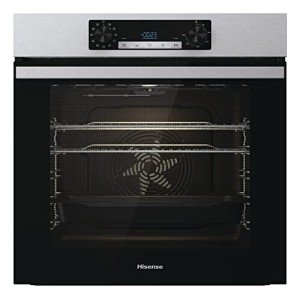Understanding Single Fan Ovens: A Comprehensive Guide
Intro
As modern-day cooking areas grow significantly advanced, appliances developed for performance and efficiency are at the forefront of customer interest. One such home appliance that remains popular amongst home cooks and baking lovers is the single fan oven, an electric model understood for its adaptability and ease of use. This post provides thorough details about single fan ovens, including their performance, advantages, types, and factors to consider for purchase.
What is a Single Fan Oven?
A single fan oven, also known as a stove, features a single cooking chamber with a fan and exhaust system that circulates hot air consistently throughout the cooking space. click to find out more results in an even cooking temperature level and boosted cooking efficiency compared to conventional static ovens.
Key Components of a Single Fan Oven
- Heating Elements: Usually situated at the leading and bottom, these create heat for cooking.
- Fan: The main feature that flows the hot air within the oven, promoting faster and more even cooking.
- Thermostat: Regulates the temperature to ensure ideal cooking conditions.
- Control Panel: Provides interface alternatives for setting temperatures, cooking times, and modes.
How Does a Single Fan Oven Work?
Single fan ovens operate by combining the heat from the heating components with the air motion produced by the fan. The hot air is distributed equally around the food, significantly minimizing cooking time while also permitting lower cooking temperature levels.
Benefits of Using a Single Fan Oven
- Faster Cooking Times: The flowing air enables food to prepare faster compared to conventional ovens.
- Even Cooking: Food is exposed to constant heat from all sides, lowering the opportunities of uneven cooking or locations.
- Flexibility: These ovens can be utilized for baking, roasting, and even barbecuing, making them appropriate for a large range of dishes.
- Energy Efficiency: By cooking at lower temperatures and in less time, these ovens may utilize less energy than their traditional equivalents.
- Moisture Retention: The style helps keep moisture in dishes, resulting in juicy roasts and baked items with a light texture.
Kinds Of Single Fan Ovens
When considering a single fan oven, consumers might encounter different types based on features and style. Here are a few common types:
1. Built-in Single Fan Ovens
- Description: Integrated into kitchen cabinets for a smooth appearance.
- Pros: Saves counter area, visually pleasing.
- Cons: Higher installation costs, might need professional help.
2. Freestanding Single Fan Ovens
- Description: Standalone systems that can be placed throughout the kitchen.
- Pros: Easy to install, flexible placement.
- Cons: Can take up more area, may not mix well with cabinetry.
3. Range Cookers with Fan Ovens
- Description: Multiple cooking choices, consisting of a fan oven, combined in one system.
- Pros: Offers numerous cooking methods, suitable for enthusiastic cooks.
- Cons: Generally more costly, larger footprint.
Contrast Table of Single Fan Oven Types
| Type | Pros | Cons |
|---|---|---|
| Built-in | Space-saving, visually pleasing | Greater expenses, expert installation needed |
| Freestanding | Flexible placement | Uses up more space, might not match kitchen cabinetry |
| Range Cooker | Multiple cooking techniques | Higher price, larger size |
Selecting the Right Single Fan Oven
When selecting a single fan oven, a number of aspects ought to be thought about to make sure that it meets individual cooking needs and fits within your kitchen layout.
Aspects to Consider
- Size and Capacity: The size needs to match your kitchen layout while providing sufficient capacity for your cooking routines.
- Features and Functions: Look for adjustable racks, self-cleaning choices, and several cooking modes to improve flexibility.
- Energy Efficiency: Check for energy ratings; some models are created to be especially energy-efficient.
- Spending plan: Costs can vary considerably, making it essential to develop a reasonable budget in advance.
Upkeep Tips for Single Fan Ovens
- Regular Cleaning: Wipe down interior surface areas after usage to avoid residue build-up.
- Examine the Fan: Ensure the fan is complimentary from blockages and operating correctly.
- Inspect Seals: Regularly check the door seals for wear and tear to preserve cooking efficiency.
- Professional Servicing: Schedule regular expert checks to ensure optimum operation.
FAQs about Single Fan Ovens
1. Can I use my single fan oven for baking?
Definitely! Single fan ovens are excellent for baking, providing consistent temperature levels necessary for cakes, cookies, and breads.
2. Is it needed to pre-heat a single fan oven?
While preheating is generally advised for optimum outcomes, due to the efficiency of a fan oven, some recipes may not require it.
3. Can I prepare several meals at when?
Yes! The even heat circulation in single fan ovens permits you to bake or roast several dishes simultaneously, making use of all rack levels efficiently.
4. Does a single fan oven cook much faster than a traditional oven?
Yes, the fan-assisted heating reduces cooking times, enabling quicker cooking.
Single fan ovens offer an extraordinary balance of speed, versatility, and performance, making them an important addition to any kitchen. Whether for baking, roasting, or daily cooking, these ovens make sure that home cooks can produce tasty meals with ease. By understanding the benefits, types, and considerations for purchasing a single fan oven, consumers can make an educated choice that lines up with their cooking desires and kitchen characteristics.
Embracing the performances of a single fan oven unquestionably leads the way for boosted cooking experiences in the contemporary kitchen.

